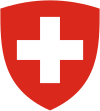1881 Swiss federal election
| This article is part of a series on the |
 |
|---|
|
|

Federal elections were held in Switzerland on 30 October 1881. The Radical Left remained the largest group in the National Council, regaining the majority they had lost in 1863.[1]
Electoral system
The 145 members of the National Council were elected in 49 single- and multi-member constituencies using a three-round system. Candidates had to receive a majority in the first or second round to be elected; if it went to a third round, only a plurality was required. Voters could cast as many votes as there were seats in their constituency.[2] There was one seat for every 20,000 citizens, with seats allocated to cantons in proportion to their population.[2]
The elections were held under the new Federal law concerning the elections of National Council members passed on 3 May 1881. The number of seats was increased from 135 to 145 following the 1880 census, and the number of constituencies from 48 to 49; Bern and Zürich both gained two seats, whilst Appenzell Ausserrhoden, Basel-Stadt, Geneva, Schwyz, Ticino and Vaud all gained one.
Results
Voter turnout was highest in Schaffhausen (where voting was compulsory) at 95.2% and lowest in Schwyz at 28.3%.
| Party | Votes | % | Seats | +/– |
|---|---|---|---|---|
| Radical Left | 39.8 | 75 | +18 | |
| Catholic Right | 24.6 | 35 | –2 | |
| Liberal Centre | 20.4 | 22 | –4 | |
| Democratic Group | 7.7 | 10 | 0 | |
| Evangelical Right | 6.1 | 3 | –2 | |
| Independents | 1.4 | 0 | 0 | |
| Total | 395,400 | 100 | 145 | +10 |
| Registered voters/turnout | 637,224 | 62.1 | – | – |
| Source: BFS (seats) | ||||
References
- ^ Elections to the National Council 1848–1917: Distribution of seats by party or political orientation Archived 2015-09-23 at the Wayback Machine BFS
- ^ a b Dieter Nohlen & Philip Stöver (2010) Elections in Europe: A data handbook, p1886 ISBN 9783832956097
